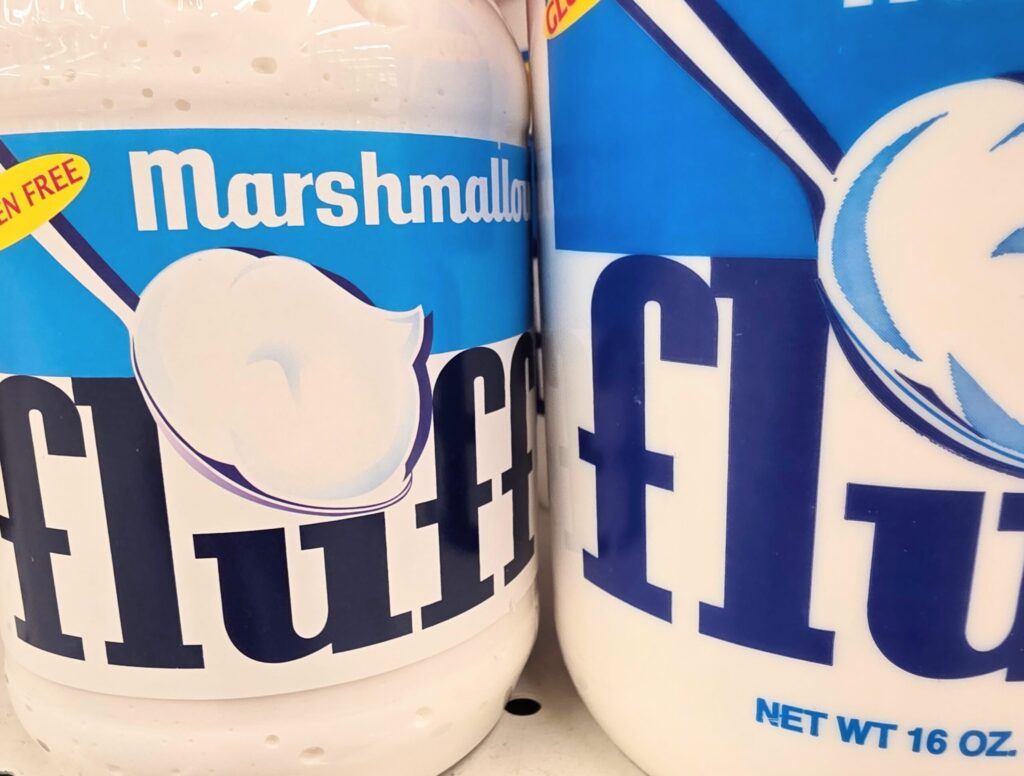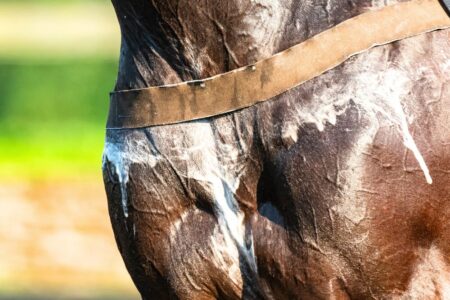The Controversy Around Marshmallow Fluff and Horses
Can you junk food your way to a higher score in the dressage ring? It’s been done! Using marshmallow fluff for horses to mimic slobbery relaxation is one way some unscrupulous riders fool the judges into thinking their horse is more chill than they are. Or has more latherin in their saliva. Either way, it’s sketchy.
Table of Contents

Why Use Marshmallow Fluff for Horses
- In the dressage ring, it’s long understood that a foamy mouth may indicate submission and respect for the bridle, showing correct contact between the dressage rider’s hands and the bit. The bubbly slobber appears to be a sign that a horse is softly chewing the bit, thus relaxing and enjoying their work. Submission and relaxation are benchmarks of allegedly higher marks in the dressage ring, and a foamy mouth is one way that some interpret this as true.
- Marshmallow fluff for horses mimics the naturally foamy mouth, showing relaxation and correct contact. It’s slathered on the lips instead of on a tasty, sweet treat more suited for the campfire. It’s made of corn syrup, sugar, and egg whites and is popular in desserts and the famous Fluffernutter sandwich, which is peanut butter and marshmallow fluff.
What makes a foamy mouth
- Horses have a laterin protein in their sweat and saliva that boosts digestion and the distribution of sweat for more effective cooling. Amazingly, this surfactant can do two jobs.
- Foam is the result of friction and latherin. You can see it when reins or butt cheeks meet a sweaty horse. Latherin will also make slobber foamy. Every horse will show this differently. Some horses sweat and make saliva more than others, and some horses have more latherin than others.
What foam doesn’t indicate
Foamy horses and foamy mouths DO NOT INDICATE:
-
- Submission
- Good contact
- Relaxation
- Stress
- Overwork
- Some horses resisting the bit or actively opening and closing their mouth are not relaxed but will still create foam. Horses that are super relaxed and happily on the bit may not make foam as they don’t have much saliva, latherin, or both.
- Sweaty horses with foamy necks or butts may have extra latherin on a humid day and have normal vitals while walking around, clearly not overworked. Horses not sweating after an hour of work in the summer may be overworked but have a sweating disorder, not much latherin, or both.
- Foam is, simply put, a reaction between protein and friction.
Understanding the Use of Marshmallow Fluff in Dressage
- Because the perception of a foamy mouth indicating good performance in the dressage ring is so prevalent, some riders use marshmallow fluff to fake it. It’s that simple.
- It doesn’t matter that foam indicates nothing except friction and latherin. The underlying belief is that it does mean something else won’t go away. This myth lives on, unfortunately!
- Extra thick fluff can also hide a horse that opens their mouth or sticks their tongue out, depending on how severe the evasion is and how much fluff is pasted on the lips.

Sugar cream in action
- I was once an FEI dressage groom, and after bridling, we would give a sugar cube to dissolve. This was a reward, and the riders believed it got the saliva and foam going. And that was that!
- Since then, some riders use the sugary cream fluffy stuff to mimic natural bubbles and slobber. And there are many firsthand accounts of this trick. It’s a real situation, even at the top levels of the sport.
Read this article about firsthand witness accounts of using fluff as a competitive advantage.
The FEI’s Response
The FEI, in 2022, created a new rule for dealing with the sugar cream fluff scandals. They declared, starting in 2023, that:
It is strictly forbidden to use any type of substance (like “marshmallow fluff”, shaving cream etc.) around the Horse’s mouth to imitate foaming; contravening this rule will entail a Yellow Warning Card and Elimination.

This isn’t a dressage horse, but you can see some foamy substance around the corners of the mouth. I have no idea if this is saliva or floof from a jar.
The USEF Response
- In response to the FEI’s rule from years ago, they state: “The rule should not penalize a horse which has naturally foamed up after being given a sugar cube, and that coloured ointment may not be used to cover up any existing wound.”
- The colored ointment refers to shoe polish or grooming sprays that conceal scars or wounds.
- The current USEF rulebook (as of 2025) does include a rule about the fluff.
Any type of substance applied around the horse’s mouth (i.e. marshmallow fluff or shaving cream) to imitate foaming is strictly prohibited under penalty of elimination.
You can read this rule on page 25 of the rulebook.
Is it safe to feed marshmallow fluff for horses?
Marshmallow fluff is not toxic but should not be used on the lips or mouth in the show ring. If you consider this sugar cream a treat, you may want to skip it and find a more natural treat like fruit or another horse-safe snack. It’s messy and sticky!
Key Highlights
- Marshmallow fluff, a sugary paste, has stirred debate in equine circles, particularly within dressage competitions.
- The substance imitates natural foaming at a horse’s mouth, raising ethical questions about fairness and authenticity.
- Riders argue it can enhance appearance and resolve contact issues for horses exhibiting tongue or bridle discomfort.
- FEI rules strictly ban its application to mimic foam, labeling it cheating and harmful to horse welfare.
- Concerns surrounding safety, the concealment of lip injuries, and integrity in riding remain focal points in these discussions.
Go Shopping
Stock up here for your horse supplies! As an Amazon Associate, I earn from qualifying purchases, but it’s ZERO extra cents to you. As a Walmart Associate, I earn from qualifying purchases as part of their affiliate plan. I appreciate your support! You can also visit my Amazon storefront here: PEG storefront.






